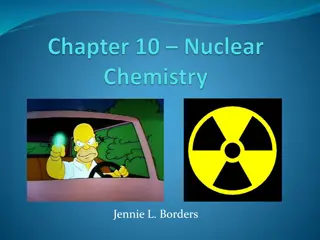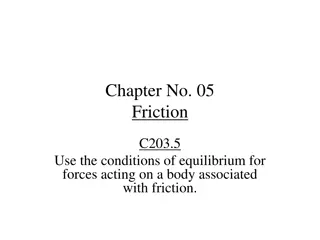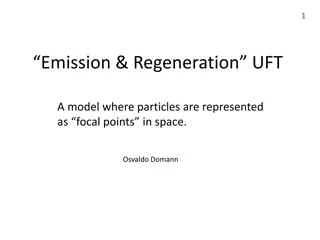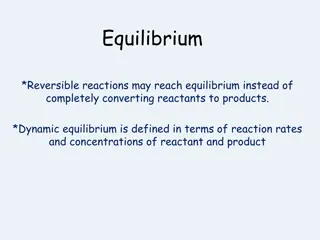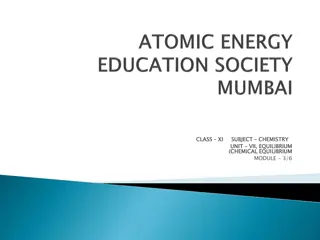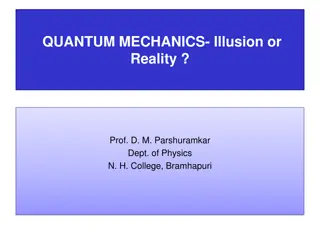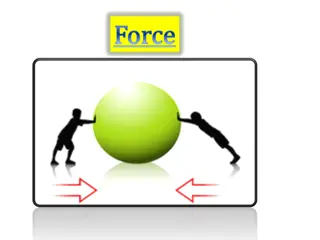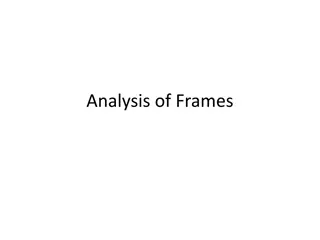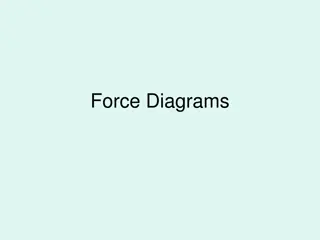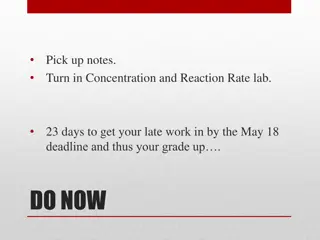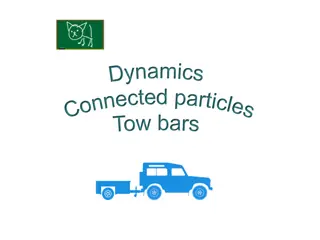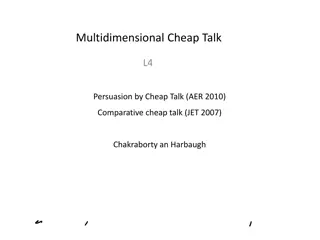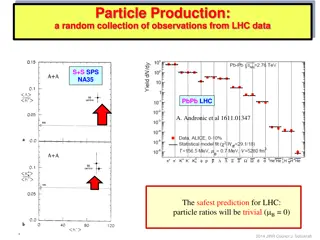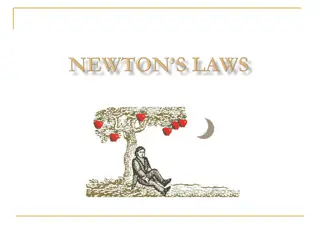Mechanics of Connected Particles: Forces and Equilibrium Model
The mechanics of connected particles through the study of forces like tension and weight, and how they interact in models of equilibrium involving pulleys and cables. Dive into Newton's three laws to understand the principles governing the motion and behavior of these interconnected systems.
Download Presentation

Please find below an Image/Link to download the presentation.
The content on the website is provided AS IS for your information and personal use only. It may not be sold, licensed, or shared on other websites without obtaining consent from the author.If you encounter any issues during the download, it is possible that the publisher has removed the file from their server.
You are allowed to download the files provided on this website for personal or commercial use, subject to the condition that they are used lawfully. All files are the property of their respective owners.
The content on the website is provided AS IS for your information and personal use only. It may not be sold, licensed, or shared on other websites without obtaining consent from the author.
E N D
Presentation Transcript
Mechanics Connected particles
Forces: Connected Particles KUS objectives BAT Set up a model of two connected particles with uniform tension on an inelastic string/cable Starter: What will be true about the Tension in a string/rope that joins two objects? Tension is equal at both ends Moo Moo
WB1 The diagram shows a cow hanging by means of a cable and pulley and held in equilibrium by a weight with mass 250 kg, the mass of the cow is 200 kg. Draw a force diagram and find all the forces in a model of this situation Tension 200 Weight (W) ????
WB1 connected particles in Equilibrium For the COW ???? = 200g = 1960 N So Tension T = 1960 N For the Weight Weight = 250g = 2450 N Tension = 1960 N Friction = 1960 837.9 Friction = 1122.1 N 2450cos20 = 2302.2 200 200 Reaction = 2302.2 N 2450sin20 = 837.9
WB 2. connected particles in Equilibrium What Forces are in operation? Tension Tension 420 420 Tension Tension Weight Weight Weight Each cow has mass = 200 kg, Mass of forklift = m
WB 2 Connected Particles (ii) Find the mass of the forklift For both COWs Weight = 200g = 1960 N So Tension = 1960 N For the forklift Both Tension = 1960 N Both j components are = 1960 sin42 = 1311.5 N 420 420 So Weight = 2623 N So mass m = 2623 9.8 = 267.7 kg
Dynamic Connected particles Pulley s
Newton's Three laws: Newton's Three laws: A particle will remain at rest or will continue to move with constant velocity in a straight line unless acted on by a resultant force Every Action has an equal and opposite reaction The Force applied to a particle is proportional to the The Force applied to a particle is proportional to the mass of the article and the acceleration produced mass of the article and the acceleration produced F = ma F = ma
WB3 Connected particles moving in different directions Problems concerning connected particles moving in different directions must be solved by considering the particles separately two particles are connected by a light, inextensible string over a smooth pulley Find the acceleration of the particles ( ) ( ) ( ) 1 ( ) 2 F R R = = mg 2 ma 2 3 T For P: mg 3 T ma For Q: T T ( ) ( ) 1 + = ma 5 g 2 mg a T T = 1 a 3m 5 a 2m P Q Find the tension in the string mg 3 mg 2 = + = ma 2 mg 2 T mg 12 For P, using (1): 5 Find the force exerted by the string on the pulley 2 = T mg 24 5
WB4 Connected particles moving in same directions Two particles P and Q of masses 6 kg and 3 kg are connected by a light inextensible string. Particle P rests on a rough horizontal table. The string passes over a smooth pulley fixed at the edge of the table and Q hangs vertically. The system starts from rest. If the Resistance force is 19.6, find a) The acceleration of Q b) The Tension in the string c) The force exerted on the pulley Fmax T P ( ) ( ) R ( ) 1 ( ) 2 = R 19 6 . 6 T a For P: pulley T = 29 4 . 3 T a For Q: Q W ( ) ( ) 1 + 2 a T = 29 4 . . 1 = = 19 09 6 . 9 a 26 1 . N Sub in (1)
WB4 Connected particles moving in same directions c) The force exerted on the pulley Resolving these forces T = 26.1 P using Pythagoras gives pulley T = 26.1 26.12+ 26.12= 36.9 Q
WB5 Connected particles moving in same directions A particle P of mass 5 kg lies on a smooth inclined plane of angle = arcsin 3/5 . Particle P is connected to a particle Q of mass 4 kg by a light inextensible string which lies along a line of greatest slope on the plane and passes over a smooth peg. The system is held at rest with Q hanging vertically 2 m above a horizontal plane. The system is now released from rest. Assuming P moves towards but does not reach the peg, find, to 3sf: a) The acceleration of Q b) How long t takes for Q to hit the horizontal plane c) the total distance that P moves up the plane. a) The acceleration of Q pulley R T T ( ) ( ) R 2 ( ) 1 = P R 49 sin 5 T a For P: Q ( ) 2 WQ WP = 39 2 . 4 T a For Q: ( ) ( ) 1 + a = 39 2 . . 1 = 29 09 4 . 9 a Same angle
WB5 (cont) b) How long t takes for Q to hit the horizontal plane = 2 s = 0 + . 1 ( 2 s = t ut + 92 . 1 = 1at 09 sec = 2 0 u 2 2 ) t 1 v 2 = . 1 09 a t R c) the total distance that P moves up the plane. T = . 2 = + First, find v after 1.92 seconds v u at ms P = . 1 ( + . 1 ( 1 0 09 ) 92 ) v 09 v WP Second, find a given that there is no longer any pull from Q (Tension) F = s = + 2 2 2 v 0 = 2.092+ 2( 5.88) u as = . 2 09 u ma = 0 v 29.4 = 5a = . 5 88 a = = . 0 371 37 1 . s cm t a = 5.88 ?? 2
WB6A particle A of mass 0.8 kg rests on a horizontal table and is attached to one end of a light inextensible string. The string passes over a small smooth pulley P fixed at the edge of the table. The other end of the string is attached to a particle B of mass 1.2 kg which hangs freely below the pulley, as shown in the diagram above. The system is released from rest with the string taut and with B at a height of 0.6 m above the ground. In the subsequent motion A does not reach P before B reaches the ground. In an initial model of the situation, the table is assumed to be smooth. Using this model, find (a) the tension in the string before B reaches the ground, a T 5 = a T g 5 5 = For B: ( ) R ( ) 2 ( ) ( ) 2 1 + a g 2 5 = g a 5 = Sub in (1) (2sf) N 7 4. = T ( ) ( ) 1 4 R For A: -2 a m s 6 6 T P A 6 3 T g 4 5 -2 a m s B 0.6 m 6 g 5
WB6 (cont) (b) the time taken by B to reach the ground. = + 2 . = 2 0 6 s ut 1at 3 gt 1 2 2 5 0 6 . 2 ( ) = t = 0. 45 s 2sf g 3 5
WB7A particle A of mass 4 kg moves on the inclined face of a smooth wedge. This face is inclined at 30 to the horizontal. The wedge is fixed on horizontal ground. Particle A is connected to a particle B, of mass 3 kg, by a light inextensible string. The string passes over a small light smooth pulley which is fixed at the top of the plane. The section of the string from A to the pulley lies in a line of greatest slope of the wedge. The particle B hangs freely below the pulley, as shown in the diagram above. The system is released from rest with the string taut. For the motion before A reaches the pulley and before B hits the ground, find (a) the tension in the string, ( ) R ( ) R ( ) 2 ( ) ( ) 2 1 + a g g 7 30 4 3 = sin a = -2 a m s ( ) 1 g 3 = 4 30 a 3 4 sin T T g a T For A: A (4 kg) = T For B: -2 a m s B (3 kg) 4 g g 3 g 7 30 = = + 4 (2sf) N 25 30 Sub in (1) sin T g g 4 7
(b) the magnitude of the resultant force exerted by the string on the pulley. T 30T 30 T A (4 kg) T 2 cos T 30 B (3 kg) ( ) = 2 cos T 30 44 N 2sf 30 (c) The string in this question is described as being light . (i) Write down what you understand by this description. (ii) State how you have used the fact that the string is light in your answer to part (a). (i) The string has no weight/mass (ii) The tension in the string is constant (same at A as B)
WB8The diagram shows two particles A and B, of mass m kg and 0.4 kg respectively, connected by a light inextensible string. Initially A is held at rest on a fixed smooth plane inclined at 30 to the horizontal. The string passes over a small light smooth pulley P fixed at the top of the plane. The section of the string from A to P is parallel to a line of greatest slope of the plane. The particle B hangs freely below P. The system is released from rest with the string taut and B descends with acceleration g. 5 (a) Write down an equation of motion for B. ( ) R 1 P -2 g m s 1 = 1.4 m T g T g 2 2 5 T 5 25 B (0.4kg) (b) Find the tension in the string. -2 g m s 1 5 A m ( kg) Using (a) g 2 1 m 5 mg ( ) = = T g g 2 2 8 g = 3. 1 N 2sf 5 25 25 30 16 (c) Prove that m= R 35 T T ( ) = 30 + sin mg mg 10 T mg = = m g 1 For A: 8 = = = = g g 80 10 16 10 m T 5 175 7 35 7 25 g mg 1 1 2 5 7
(d) State where in the calculations you have used the information that P is a light smooth pulley. The tension in the string is constant (same at A as B) On release, B is at a height of one metre above the ground and AP = 1.4 m. The particle B strikes the ground and does not rebound. (e) Calculate the speed of B as it reaches the ground. P = v + 0 2 2 2 2 v u 2 as + m 2 -2 g m s 1 5 = 2 1 g 1 2 5 -1 g ms 2 5 = -1 = 2 0 . ms (2sf) v g 2 5 16 g 35 (f) Show that A comes to rest as it reaches P. = 2 + g 2 2 2 + v u = = as 2 -1 g ms 2 When B hits the floor, A is moving at ( ) 5 = 0 v g 2 1 2 5 0 2 5 Between then and A stopping, only gravity is acting: ( ) R g = 35 30 sin v at P = 2 ms a g 1 16 16 a 2 35
Skills H HWK H
BAT Set up a model of two connected particles with uniform tension on an inelastic string/cable KUS objectives self-assess One thing learned is One thing to improve is


